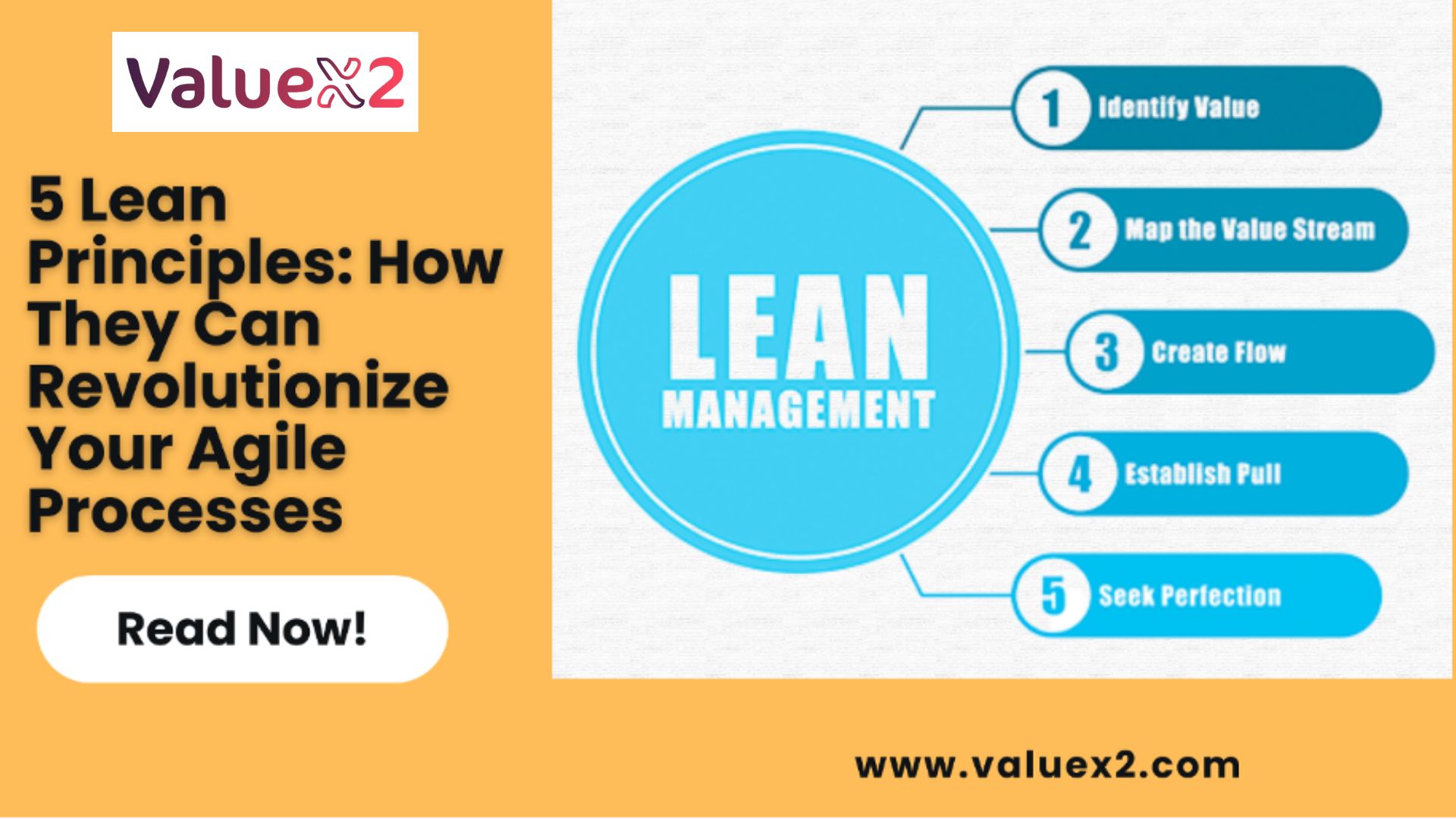Know the 5 foundational Lean principles that can boost your processes. Find out how these Lean principles help streamline, optimise, and bring brilliant results. Get detailed knowledge about the 5 Lean principles with examples.

In the current fast-paced global enterprise environment, businesses are continuously seeking out approaches to streamline their processes and boost performance. One famous methodology for accomplishing these desires is Lean-Agile, a control framework that mixes the concepts of lean production with the Agile technique for software improvement.
At its centre, Lean-Agile is all about delivering cost to clients quickly and continually while minimizing waste and optimizing sources. To achieve this, Lean Agile employs five key concepts that help teams work together more effectively and make continuous improvements to their procedures.
These standards are:
Value: Delivering value to the client is the number one goal of any lean-agile team.
Value Stream: Mapping out the entire fee circulation, from beginning to end, can help teams perceive and remove waste.
Flow: Creating a smooth, non-stop flow of work can reduce delays and bottlenecks.
Pull: Teams need to work on what is needed when it’s needed to keep away from overproduction and extra stock.
Perfection: The pursuit of perfection is in no way an endless adventure, but it could result in big upgrades in performance and exceptional results.
By enforcing these 5 Lean Principles in their Agile techniques, teams can reduce waste, enhance productivity, and ultimately supply higher-quality products and services to their clients. In the subsequent sections, we’re going to discover each of those principles in more detail and offer examples of ways they may be put into practice.
Principle – 1
Value is defined as everything that the client is willing to pay for in a lean-agile manner. The core purpose of each Lean-Agile team is to provide a fee to the patron, and everything they do has to be centred on doing so.
The capabilities and functions necessary to be able to provide the most value to the patron need to be decided and given the very best precedence to accomplish this. This involves closely participating with the purchaser to realize their demands and possibilities and making use of that information to direct the improvement system.
Toyota and Amazon are agencies that have efficiently implemented this principle. Amazon makes use of record analytics to personalize the customer experience and show merchandise that is, in all likelihood, precious to every unique patron. Toyota uses a “just-in-time” manufacturing system to deliver precisely what the purchaser wishes. These corporations have been successful in forging close bonds with their customers and maintaining a competitive edge in their sectors by targeting and presenting costs.
Principle – 2
The concept of value circulation is critical to the Lean-Agile technique. A value move is the set of activities required to provide a product or service from beginning to end. By mapping out the complete price circulation, teams can pick out regions of waste or inefficiency and eliminate them.
Mapping out your price move can offer several benefits, including:
Improved visibility: By visualizing the whole fee circulation, teams can get a better understanding of the way distinctive activities and procedures match together.
Identification of waste: By reading the fee move, teams can discover regions of waste or inefficiency, consisting of unnecessary handoffs or delays, and work to put them off.
Better aid allocation: By knowing how the entire fee circulates, teams can allocate resources more effectively, ensuring that work is shipped evenly and that no bottlenecks arise.
Improved first-class: By identifying areas of waste and inefficiency, teams can also become aware of capacity-best issues and work to eliminate them, resulting in a more satisfactory end product.
Many companies have efficiently optimized their fee streams by using this principle. For example, Toyota famously used price circulation mapping to perceive and cast off waste in its production tactics, resulting in widespread upgrades in performance and first-rate quality. By mapping out their cost streams and making continuous upgrades, Lean-Agile teams can acquire similar effects from their own processes.
Principle – 3
One of the five Lean Principles is drift, which refers to establishing an easy and continuous flow of hobbies. Flow is described in the Lean-Agile methodology as the elimination of bottlenecks and delays within the production process by ensuring that work moves via the device as fast and efficiently as possible.
Creating a wholesome glide is critical, as it allows teams to offer services to consumers quicker and with fewer pauses or delays. Teams can create better-than-first-class work and entire initiatives faster by eliminating idle time and waiting periods among activities.
Spotify, which employs a “Squad” version to structure its teams and assure that work is always flowing via the device, is an actual global example of a company that has improved its Agile processes by going with the flow. Similarly, Toyota has mounted a “Just-in-Time” (JIT) system, which lowers stock and assures that components are supplied to the manufacturing line at the right time they’re required.
Overall, the flow concept is a vital element of the lean-agile approach and is needed for each team looking to grow production and efficiency. Teams may also remove waste and offer better results to their customers by concentrating on generating an easy and continuous stream of hobbies.
Principle – 4
The pull system is a precept in Lean-Agile that involves most effectively beginning work on a mission while there is demand for it. This approach facilitates reducing waste and improving performance by ensuring that work is only done when it is needed. Implementing a pull system can provide several advantages to agile approaches, including decreased lead times, elevated responsiveness, and stepped-forward float. Companies like Toyota and Dell have effectively used the pull system to optimize their manufacturing procedures, and agile teams can also apply this principle to their workflows to improve efficiency and output.
Principle – 5
Perfection is the fifth principle of Lean-Agile. This precept highlights the cost of steady improvement and striving for perfection in all facets of a team’s work. It acknowledges that while perfection is never absolutely practicable, striving for it could bring about extensive upgrades in efficiency, quality, and customer happiness. Teams may also find opportunities for optimization and make modest modifications that build up to big advantages over the years by frequently assessing and enhancing their processes. Principle 5’s closing cause is to foster a lifestyle of persistent increase and a mindset of continuously striving to do better.
Conclusion
Finally, the 5 Lean Principles have the potential to regulate Agile strategies by using supporting teams to work extra efficiently, hand over higher products, and grow customer pride. Teams may get rid of waste and provide extraordinary items and offerings by targeting handing over cost, optimizing the price flow, producing a seamless flow of work, working on what’s required while it’s wanted, and constantly aiming for excellence.
We invite you to use these ideas in your organization and see the consequences for yourself. Keep in mind that Lean-Agile adoption is a continuous process that calls for a tradition of constant improvement in addition to the willingness to conform and modify as desired.

Bhavna is an Agile Coach and Consultant with over a decade of experience in advisory, corporate finance, IT assurance, and operations at Big 4 and within the industry in the UK and India. She has recently been the CEO of a start-up where she implemented agile practices within HR, Marketing, and Product teams.
She is also a SAFe® Practice Consultant (SPC) and authorized instructor for ICAgile Agility in HR (ICP-AHR), Agility in Marketing (ICP-MKG), and Business Agility Foundations (ICP – BAF) training courses. She provides training for agile transformation to corporate, public, and private batches, as well as consulting for enterprise agile transformation.






